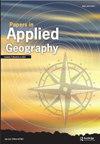Using sUAS-Derived Point Cloud to Supplement LiDAR Returns for Improved Canopy Height Model on Earthen Dams
Q2 Social Sciences
引用次数: 2
Abstract
Abstract Of the nearly 2,400 regulated dams in South Carolina, USA, 97% are earthen dams. Many of these dams are covered in dense vegetation that impede inspections and increase slope instability. Because of their relatively spatially coarse collections, LiDAR datasets are often insufficient on small earthen dams for adequately characterizing both the ground surface and vegetative cover. This study tests the feasibility of small Unmanned Aerial Systems (sUAS) derived “image returns” in extracting a canopy height model (CHM) on a private dam in Columbia, South Carolina. Following traditional methods for creating a CHM from 3D point clouds, both LiDAR- and sUAS image-derived datasets were used to create a composite CHM. A validation process used a set of 30 in situ measured tree heights compared to their modeled heights from the sUAS only, LiDAR only, and composite CHMs. In terms of the root mean squared error (RMSE), the LiDAR only model (5.60 m) outperformed the sUAS only (8.17) and LiDAR + sUAS (7.23 m) composite models. Findings from this study suggest that sUAS derived point clouds have potential, but the structure from motion (SfM) technology and supporting ground control need to be improved before operational application on canopy height modeling for dense vegetation over earthen dams.利用suas衍生点云补充激光雷达反演改进土坝冠层高度模型
在美国南卡罗来纳州近2400座受监管的水坝中,97%是土坝。许多水坝被茂密的植被覆盖,阻碍了检查,增加了边坡的不稳定性。由于其相对粗糙的空间收集,激光雷达数据集往往不足以充分表征小土坝的地表和植被覆盖。本研究测试了小型无人机系统(sUAS)在提取南卡罗来纳州哥伦比亚市一座私人水坝的冠层高度模型(CHM)中的“图像返回”的可行性。遵循传统的从3D点云创建CHM的方法,使用LiDAR和sUAS图像衍生数据集创建复合CHM。验证过程使用了一组30棵原位测量的树木高度,并将其与仅使用sUAS、仅使用LiDAR和复合CHMs的模拟高度进行了比较。在均方根误差(RMSE)方面,仅LiDAR模型(5.60 m)优于仅sUAS (8.17 m)和LiDAR + sUAS (7.23 m)复合模型。本研究的结果表明,sUAS衍生点云具有潜力,但在应用于土坝上茂密植被的冠层高度建模之前,需要改进运动结构(SfM)技术和配套的地面控制。
本文章由计算机程序翻译,如有差异,请以英文原文为准。
求助全文
约1分钟内获得全文
求助全文

 求助内容:
求助内容: 应助结果提醒方式:
应助结果提醒方式:


